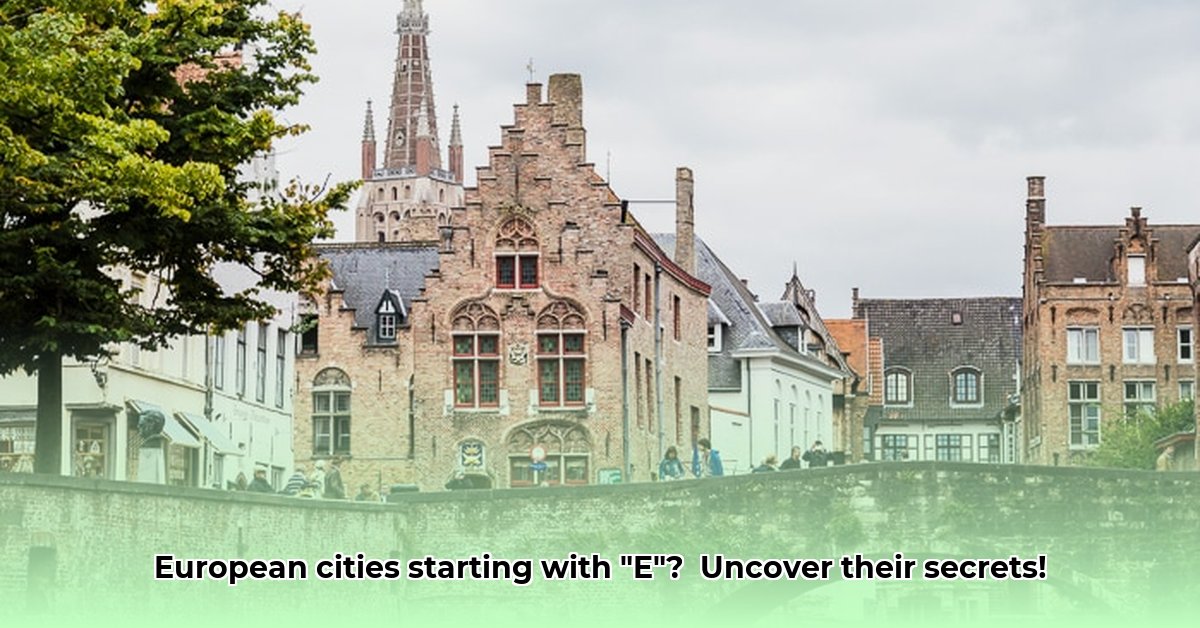Have you ever wondered about the cities in Europe that begin with the letter “E”? These cities, ranging from well-known capitals to hidden gems, offer a fascinating lens through which to examine Europe’s diverse and evolving population. This article delves into the demographics of these cities, exploring population sizes, growth trends, and the factors shaping their communities. We’ll unravel the stories behind the statistics, providing insights into the opportunities and challenges these cities face. For a more comprehensive list, check out this helpful resource.
The Enigmatic “E” Cities: A Demographic Overview
Embarking on a journey to explore the demographics of European cities starting with “E” reveals a complex and intriguing landscape. While compiling a definitive list seems straightforward, variations in city definitions and data collection methodologies introduce certain challenges. Understanding these nuances is crucial for accurate comparisons.
Defining “City”: A Methodological Maze
Creating an exhaustive list of European cities starting with “E” requires careful consideration of what constitutes a “city.” Statistical agencies employ diverse criteria, with some focusing on core urban boundaries and others encompassing broader metropolitan areas. This inconsistency can lead to significant discrepancies in population figures, making direct comparisons difficult. Aligning international census methodologies presents intricate logistical and conceptual hurdles.
A Tapestry of Sizes: From Metropolises to Quaint Towns
Despite the definitional challenges, the spectrum of “E” cities showcases a remarkable diversity in size. Ranging from sprawling metropolises with millions of residents to charming towns with distinct character, these cities reflect the varied historical and economic forces that have shaped Europe. The relationship between city size and economic opportunity warrants further investigation.
A Closer Look at Select “E” Cities
The following table provides a snapshot of selected European cities beginning with “E,” highlighting key demographic data and notable features. Population figures are estimates based on the latest available data, subject to variations in methodology.
| City Name (English/Native) | Country | Estimated Population (2024) | Population Trend | Notable Fact |
|---|---|---|---|---|
| Edinburgh (Edinburgh) | Scotland/UK | Approximately 550,000 | Steady Growth | Scotland’s capital city, renowned for its rich history, iconic landmarks, and vibrant cultural scene; a major tourist destination and center for education and finance. |
| Essen (Essen) | Germany | Approximately 585,000 | Stabilizing | Located in the Ruhr area, Essen was once a coal mining and steel production hub. It’s now undergoing a revitalization, focusing on arts, culture, and renewable energy. |
| Eindhoven (Eindhoven) | Netherlands | Approximately 245,000 | Steady Growth | Known as a tech and design center, Eindhoven is home to numerous high-tech companies and design studios. |
| Erfurt (Erfurt) | Germany | Approximately 215,000 | Moderate Growth | The capital of Thuringia, Erfurt boasts a well-preserved medieval old town and a rich cultural heritage. |
| Elche (Elx) | Spain | Approximately 235,000 | Slow Growth | Elche is famous for its extensive palm groves, a UNESCO World Heritage site, and its traditional Misteri d’Elx (Mystery Play of Elx). |
| Enschede (Enschede) | Netherlands | Approximately 160,000 | Steady Growth | Enschede has a textile industry and ITC, is known for its vibrant student life, cultural events like Grolsch Summer Sounds, and proximity to the German border, fostering cross-border collaborations and exchange |
| Exeter (Exeter) | England/UK | Approximately 135,000 | Moderate Growth | This historic cathedral city features Roman walls, a medieval guildhall, and a lively quayside. The University of Exeter contributes to its youthful atmosphere and provides opportunities for research and innovation, making Exeter an attractive place to live and work. |
Note: Population estimates are subject to change depending on the source and methodology used.
Drivers of Demographic Change: Migration and Economic Forces
Population trends are influenced by a complex interplay of factors, including migration patterns, economic conditions, and government policies. Understanding these drivers is essential for comprehending the demographic dynamics of “E” cities.
For instance, some cities attract skilled workers and international migrants due to thriving industries and attractive employment prospects. Conversely, others may experience population decline due to economic stagnation or limited job opportunities. Migration patterns and their correlation with a city’s economic vitality are key indicators of demographic change.
Opportunities and Challenges: Planning for the Future
The demographic trends in “E” cities present both opportunities and challenges for urban planners and policymakers. Expanding cities may face pressures on housing, infrastructure, and public services, while shrinking cities may grapple with economic decline and abandoned properties. Proactive planning and adaptive strategies are essential for ensuring the long-term sustainability and prosperity of these urban centers.
This overview offers a starting point for understanding the demographic complexities of European cities starting with “E.” Further research is needed to fully unravel the intricate dynamics shaping these urban landscapes. By studying population trends, we can gain valuable insights into the challenges and opportunities facing these cities and contribute to informed planning and development strategies.
Demystifying Data: Comparing European City Populations that Start with “E”
Embarking on a quest to compare the populations of European cities starting with “E” quickly reveals a data labyrinth. The challenge lies not just in finding the numbers but in ensuring they are comparable. Different methodologies and definitions complicate direct comparisons, demanding a critical and nuanced approach.
The “City Limits” Conundrum: Defining Urban Boundaries
A primary source of discrepancy stems from differing definitions of “city limits.” Some data reflects the population within the administrative boundaries of the city proper, while others encompass the broader metropolitan area, including suburbs and surrounding communities. This variance significantly impacts population figures, rendering direct comparisons unreliable. Standardization of measurement techniques can improve this.
Navigating the Numbers: A City-by-City Analysis
Let’s examine specific “E” cities, acknowledging the data challenges:
| City Name (English/Native) | Country | Population Estimate (2024) | Demographic Trends | Notable Characteristics |
|---|---|---|---|---|
| Edinburgh (Edinburgh) | Scotland/UK | ~ 550,000 | Steady Growth, driven by tourism and economy. | Scotland’s capital, known for its historic castle, vibrant arts scene, and strong economy fueled by tourism, finance, and education. Its continued growth is attracting people from around the world. |
| Essen (Essen) | Germany | ~ 585,000 | Stabilizing after decline, economic transition. | Located in the Ruhr region, Essen was once a major industrial center. Now it’s transforming into a service and technology hub, attracting new businesses and residents. Cultural institutions are a big draw here. |
| Eindhoven (Eindhoven) | Netherlands | ~ 245,000 | Steady Growth, fueled by technological industry. | A hub for technology and design, Eindhoven is home to many innovative companies and research institutions. The city attracts a skilled workforce and is a center for research and innovation. |
| Elche (Elx) | Spain | ~ 235,000 | Slow Growth, cultural and historic significance. | Known for its UNESCO-listed palm groves, Elche is a unique and historic city in southeastern Spain. It attracts tourists and is a center for agriculture and culture. The city’s old town is a historical area. |
| Enschede (Enschede) | Netherlands | ~ 160,000 | Steady Growth, diverse economy and cross-border influence. | A vibrant city near the German border, Enschede has a diverse economy ranging from industry to services. Its proximity to Germany creates cross-border partnerships. |
| Erfurt (Erfurt) | Germany | ~ 215,000 | Moderate Growth, historic charm and university life. | With a well-preserved medieval center, Erfurt has a rich history and a bustling university scene. The university contributes to the city’s vibrant atmosphere and attracts students from across Germany. |
Note: Population figures are approximate and may vary based on data source and definition of “city limits.” It is important to know that figures within the table can fluctuate.
Decoding Data Discrepancies: Methodological Matters
What underpins these inconsistencies? Data collection methodologies vary across countries, with some nations employing more comprehensive systems than others. Variations in census frequency, data sources, and statistical definitions contribute to discrepancies. The lack of uniformity necessitates careful interpretation and comparison.
A Practical Guide to Reliable Data
To navigate these challenges, consider these strategies:
- Decipher Methodologies: Prioritize understanding the data collection methodology. Does the figure represent the city proper, the
- Spiritual Connotation of Names Reveals Their Divine Meaning and Purpose - November 18, 2025
- Unpacking the Importance of Names in the Bible for Deeper Understanding - November 17, 2025
- Avery Biblical Meaning Infers Wisdom, Counsel, and Protection - November 16, 2025










